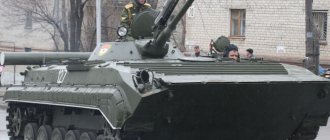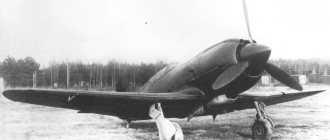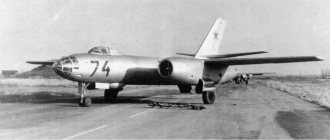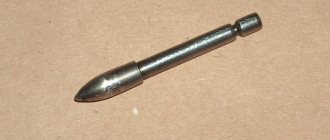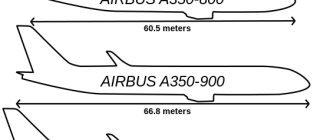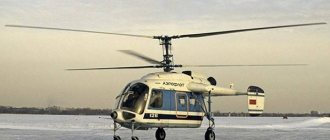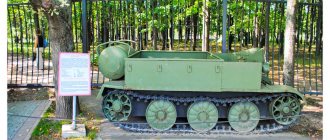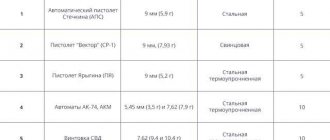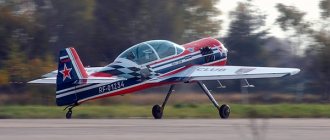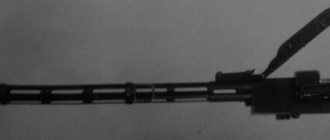The Il-112 aircraft is a light transport aircraft project developed by the Ilyushin design bureau. The main task of this device was to replace old An-26 type aircraft. The designers' plans were to create two modifications for civil aviation and for the transportation of military cargo.
In the 90s, monitoring of the aircraft market was carried out, which showed that the domestic market of the CIS requires Il-112 aircraft in quantities from 300 to 1 thousand aircraft. The advantage of this device is that it can be used on poorly equipped and short runways, even with unpaved surfaces. The operating system provides for the use of the machine without major repairs, you only need to maintain the serviceability level. According to the forecasts of the creators of the IL-112, its operational life should be 35 years.
The history of the creation of the Il-112 aircraft
The development of the project began in the early 90s; initially they planned to produce a passenger vehicle. Was involved in financing the project. They wanted to start serial production in 1994 at the Kumertau APO. These plans were never implemented. As a result, serial production was transferred to the Voronezh ASO.
This project was presented to the Ministry of Defense of the Russian Federation in 2004, after which they planned to create a working aircraft in 2006. But this too was not implemented due to further delays in the development of the project. Financing was provided by the Ilyushin Design Bureau, and this device was included in the state defense order until 2020.
IL-112V modification view here
The Ministry of Defense suspended funding in the summer of 2010, despite the fact that four Il-112s had already been partially built. To fully upgrade these machines, 800 million rubles are missing.
Ultimately, VASO prepared four prototypes of the aircraft, and two of them are flightable. Manufacturers plan to produce 18 such machines per year. Another problem was the refusal of the Ministry of Defense from transport variants of the Il-112 in 2011 in favor of the An-140. For this reason, development of the Il-112 transport aircraft was discontinued.
In the winter of 2014, Ilyushin’s company entered into a new agreement with the Ministry of Defense, which deals with the further development of the Il-112 transport vehicle. It is planned to be manufactured in 2020, and serial production is planned to begin in 2020.
In the first half of the 1990s, the Ilyushin Design Bureau proposed a shortened version of the Il-114 under the working name Il-112. The project was not implemented and later the index 112 moved to a completely different aircraft - a military transport Il-112V. The Il-112V program started in 2002, when the Russian Air Force announced a competition for the creation of a promising light military transport aircraft (LMTA) with a payload capacity of 5-6 tons, which was supposed to replace the aging An-26 in state aviation. serial production of which at the aircraft plant in Kyiv ceased back in 1986. In March 2003: the customer’s commission reviewed the preliminary designs. submitted to the tender by AK them. S.V. Ilyushin. ANTK im. A. N. Tupolev, RSK MiG, Sukhoi Design Bureau and EMZ named after. V.M. Myasishchev, and on April 8 of the same year announced the Il-112V project as the winner of the competition.
The Ilyushin team began developing a preliminary design of a new aircraft, the defense of which and the mock-up commission took place in December 2004, and after that - its detailed design. For a number of reasons, this stage dragged on, and in 2010, funding for the work from the customer was suspended... Chief designer of PJSC Il Nikolai Talikov recalls: “We started developing the Il-112V back in 2003, when we won the competition of the Ministry of Defense Russia. We successfully passed the stage of the preliminary design, the mock-up commission, and in 2005 we began development work. To be honest, this stage took a little longer: in the process of work we had to change the developer of the sighting, navigation and flight system (PrNPK). At the end of 2007, it became the St. Petersburg “Kotlin-Novator”, known for its flight control and navigation systems for transport aircraft of various types, incl. and for our IL-76. The change of contractor caused a delay in the R&D work for about three years. Moreover, by that time the documentation for the airframe was almost ready, but there was still a considerable amount of work to be done on the equipment. The defense of the preliminary design for the Il-112V avionics complex took place in December 2008. As a result, by 2010 we had produced almost 95% of all working design documentation and transferred it to the manufacturing plant in Voronezh. They began launching documentation into production, began manufacturing equipment, preparing workshops... But in May 2010, a document was received from the Ministry of Defense, according to which funding for work on the aircraft was suspended. Until August 2010, we continued to work at our own expense, after which it was stopped. There has been no work on the Il-112V for more than three years: we have completely switched to building and fine-tuning the Il-76MD-90A.”
It was possible to return to the issue of resuming the development of the Il-112V only in October 2013, when a meeting was held with Deputy Minister of Defense (now Deputy Prime Minister of the Russian Government) Yuri Borisov. At the same time, taking into account the passage of time, the technical specifications for the Il-112V were slightly adjusted. According to Nikolai Talikov, the changes concerned mainly only the use of new on-board communications and defense systems and partly flight and navigation equipment: they had to be carried out taking into account the maximum possible unification with similar systems used on the Il-76MD-90A.
After agreeing on all financial and organizational issues, in November 2014, a state contract was concluded for development work, including the construction at VASO of the first two prototypes of the Il-112V (flight and endurance) with the aircraft entering flight tests no later than June 2020. Defense the technical design and presentation to the customer of a full-size mock-up of the Il-112V flight deck took place in June 2020. At the same time, the industrial cooperation scheme for the construction of the Il-112V was finally approved. The head enterprise for the production of the Il-112V, as before, remains VASO, which is responsible for the manufacture of fuselage compartments, wings, empennage, engine nacelles, docking of units, final assembly, painting and carrying out a complex of flight tests of all aircraft under construction, starting with the first flight model. Fuselage panels, hatches and doors are manufactured and supplied to VASO by the Ulyanovsk JSC Aviastar-SP, brake flaps, spoilers, fairings of the flap rails, panels of the tail section of the wing, ailerons, elevator and rudder trimmers - by the Kazan JSC KAPO-Composite, landing gear and hydraulic cylinders - Samara JSC Aviaagregat of the Tekhnodinamika holding, etc.
The Il-112V power plant included two new TV7-117ST turboprop engines with a maximum take-off power of 3100 hp. (in increased emergency mode - 3600 hp) developed and produced by JSC "OD K-Klimov" with six-blade propellers AV-112 from Stupino Research and Production Enterprise "Aerosila" (the same company supplies the Il-112V with the TAI-130 auxiliary power unit -112). Testing of the experimental TV7-117ST with the AV-112 propeller at the stand of JSC "ODK-Klimov" started in September 2020, on the Il-76LL flying laboratory - in September 2020. In addition to the Klimov, MMP is involved in the cooperation for the serial production of such engines them. V.V. Chernysheva and a number of other enterprises of the United Engine Corporation. One of the features of the TV7-117ST is that the BARK-65STM automatic control system created by UEC-Klimov controls the operation of not only the engine, but also the propeller - i.e. the entire power plant of the aircraft, which makes it possible to fully utilize the potential of the characteristics of the engine and propeller and generally increase the efficiency of the power plant. It is worth noting that the civilian modification of the engine for the Il-112V - TV7-117ST-01 - will become the standard power plant of the regional passenger aircraft Il-114-300, and the turboshaft TB7-117V, unified with the TV7-117ST in terms of gas generator, is installed on Mi-38 helicopters. serial production of which begins this year.
The integrator and supplier of the avionics complex for the Il-112V is the St. Petersburg JSC Kotlin-Novator, which is responsible for the PrNPK-112 sighting, navigation and flight complex with the control computer system U BC-112V. complex electronic indication and alarm system KSEIS-112B and multifunctional weather navigation radar complex MPJ1K-112B. providing the solution to all required flight, navigation and special tasks, including landing of cargo, equipment and personnel. The same company has developed a general aircraft equipment control system SUOSO-112V for the aircraft, which makes it possible to automate the actions of the crew when working with all on-board systems - fuel, hydraulic, fire safety, power supply, air conditioning, etc., as well as with the power plant and wing mechanization.
Radio engineering navigation systems (early warning of the proximity of the earth, on-board equipment for working with radio beacons of short-range navigation and instrumental landing systems, radio rangefinder, radio-technical equipment for short-range navigation and landing, aircraft radar transponder, etc.) are supplied by the St. Petersburg JSC VNIIRA-Navigator. Suppliers of Il-112V equipment are also several enterprises of the Radioelectronic Technologies (KRET) concern, in particular, Aeropribor-Voskhod JSC has created an information complex for the altitude and speed parameters IKVSP-112V for the aircraft. KRET is also responsible for the airborne defense complex, and the developer of the onboard communications complex is the Nizhny Novgorod NPP Polet.
Enterprises of the Technodinamika holding, in addition to the already mentioned landing gear and hydraulic cylinders (developed and produced by the Samara Aviaagregat), provide the supply of AC power supply system units for the Il-112V (Ufa UAPO and UNPP Molniya), the latest electric drive system for moving the flaps ( Kirov "Electric Drive"), etc. Thus, the main part of the Il-112V on-board systems was developed and manufactured by enterprises of the Rostec state corporation (within its holdings UEC, KRET OPK, etc.), into which UAC itself is currently being integrated.
The first parts and components of the Il-112V long-term manufacturing cycle were put into production at VASO by the fall of 2020, and in May 2020 they arrived here from Ulyanovsk | "Aviastar" first fuselage panels. Before | At the end of the year, VASO received from Ulyanovsk all the fuselage panels, hatches and doors required for the assembly of both prototype aircraft. In November 2020, in Voronezh, the fuselage of the flying prototype Il-112V (No.0101) was completed; by the beginning of next year, work on the manufacture of the original one-piece wing was completed, and the aircraft entered the final assembly shop. During 2017, the first flight model airframe was assembled, engines were installed, and on-board systems were installed. Due to delays in the supply of a number of components and the need to adjust the working design documentation, the planned dates for the aircraft to be released for testing had to be postponed: the rollout to June-July, and the first flight to October 2020. Subsequently, these dates were shifted by several more months.
The workshop testing of the Il-112V No.0101 under current began in April last year, the first test of the fuselage tightness and moisture resistance was carried out in May, and frequency tests were carried out in September. On the first flight model, preliminary static tests were also carried out in the VASO assembly shop - to the extent necessary to ensure the first flight and the initial stage of flight tests. Full-scale static and endurance tests of the Il-112V were supposed to be carried out at TsAGI on the airframe of the second prototype (No. 0102), the production of which was completed in Voronezh last fall, after which it was disassembled and transported by road to Zhukovsky near Moscow in December 2018.
The ceremonial rollout of the first flight model of the Il-112V to the factory flight test station took place after the completion of the workshop stage on November 27, 2020. A month later, on December 28, the first taxiing was carried out, and the second on January 26. They alternated with breaks to debug on-board equipment and refine the power plant. After the identified problems were eliminated, several more taxiing and runs took place in mid-March. Finally, on March 28, the industry methodological council met, which, having considered all the materials presented by the developer on the stages of ground testing and development of the prototype aircraft, gave a positive conclusion on its first flight. The next day, at the VASO airfield, a high-speed run took place with the landing gear wheels lifting off the runway and subsequent braking, which confirmed the IL-112V’s readiness for flight. The day before, the Il-114JTJI (No.91003) arrived from the Leningrad region to Voronezh, which they decided to use as an escort aircraft for the Il-112V on the first flight to ensure control of flight parameters, aerial observation of the prototype and its video recording.
Saturday, March 30, 2020 has arrived - the day of the 125th anniversary of Sergei Vladimirovich Ilyushin. In the morning, a Yak-42 arrived at the VASO airfield from Moscow, on board of which were Deputy Chairman of the Russian Government Yuri Borisov, UAC President Yuri Slyusar, and other leaders and specialists. So far the weather is not conducive to the first flight - the airfield is gloomy, the clouds are too low. Everyone is waiting for improved weather conditions. Finally, by noon, the lower edge of the clouds rises, and the General Director of PJSC Il Alexey Rogozin - according to the Ilyushin tradition, on the hood of a black Volga GAZ-24 right in front of the plane - signs the assignment for the first flight. The crew - Honored Test Pilot of the Russian Federation, Hero of Russia Nikolai Kuimov, co-pilot test pilot Dmitry Komarov and flight engineer Sergei Fedorov - have already taken their places in the Il-112V cockpit.
The flight director gives the go-ahead to start the engines. An Il-114LL escort aircraft taxis onto the runway and takes off around 12.00. Another 10 minutes - and the Il-112V with tail No. 41400 is at the executive start. Nikolai Kuimov shifts the engine control levers to takeoff mode, an energetic takeoff run - and at 12.11 the newest military transport aircraft is in the air! Climbing, checking stability and controllability, assessing the operation of the power plant and the main on-board systems - everything is going as expected. As usual, the landing gear and mechanization are not retracted during the very first flight. 12 minutes after takeoff, the Il-112V is again shown above the airfield - a pass is made over the runway, 15 minutes later - again, with a simulated approach and go-around. Another quarter of an hour - and the Il-112V is on the landing glide path, at 12.53 its wheels softly touch the runway, a short run, and the plane taxis to a group of jubilant greeters. “The board is the norm,” reports Nikolai Kuimov. Traditional “swings” from the crew commander and congratulations from the assembled leaders and colleagues. Next, the co-pilot and flight engineer are greeted with the same warmth. The first flight was successfully completed: according to the crew’s reports, all onboard systems of the new aircraft worked as expected, the aircraft’s behavior in the air was predictable, piloting was comfortable, there were no serious complaints.
“Today I would like to congratulate the team of the Voronezh aircraft plant, the designers and engineers of the Design Bureau named after. S.V. Ilyushin with the first flight and the most important stage in the creation of a new aircraft,” said UAC President Yuri Slyusar after the successful completion of the first flight of the Il-112V. — Transport aviation is one of the corporation’s priorities. We, by analogy with civil aviation, are forming a full-fledged line of military transport aircraft. Today in Voronezh we took to the skies the Il-112V light transport aircraft, serial production of the Il-76MD-90A heavy transport aircraft begins in Ulyanovsk, and a project for a medium transport aircraft is in development. The Il-112V light transport aircraft should replace outdated An family vehicles. There is huge pent-up demand here. Our task now is to fulfill all obligations to the main customer, the Ministry of Defense, to successfully conduct tests and begin deliveries of the aircraft.”
“This is an important stage for the formation of the military aviation fleet due to the arrival of new aircraft created in Russia,” said, in turn, Deputy Prime Minister of the Russian Government Yuri Borisov, who was present at the first flight of the new aircraft, supervising the military-industrial complex. — The IL-112V is not only a transport aircraft, but also a unique platform that can be used for a wide range of military and civilian missions. The vehicle is being built entirely from domestic components and will be equipped with equipment based on Russian components. Our common goal is to make an aircraft that is not inferior to modern foreign analogues.”
In accordance with the technical specifications, the Il-112V light military transport aircraft is designed to transport a variety of cargo, personnel, weapons and light military equipment with a maximum weight of up to 5 tons with the possibility of parachute landing. The key advantage of the aircraft should be the ability to operate autonomously from poorly prepared and pound runways, in difficult climatic conditions, incl. from high-mountain airfields and at ultra-low temperatures. The Il-112V, which has a maximum take-off weight of 21 tons, must fly at a cruising speed of 470-500 km/h at altitudes up to 7600 m. According to official data from the UAC, the flight range with a maximum load when taking off from pound airfields should be 1200 km, range with a 3.5 t fuser - 2400 km.
The leaders of Ilyushin do not hide the fact that during the construction of the first flight model of the Il-112V, the problem of overweighting of the structure was revealed, as a result of which, according to the calculations performed, the flight range with a full load may be less than the required one. In this regard, last year a comprehensive plan was approved to reduce the weight of the aircraft: a decision was made to redesign a number of structural elements, ensure a wider use of composite materials and slightly rearrange the placement of equipment units. As a result, the empty weight of the aircraft will be reduced and loaded range requirements must be met. The next two flight models of the Il-112V (No.0103 and 0104) will receive a lightweight design. construction of which is scheduled to begin this year.
Based on the results of flight tests, a contract is expected to be concluded with the Russian Ministry of Defense for serial deliveries. Previously, Yuri Borisov, then still the Deputy Minister of Defense, had repeatedly stated that the military planned to order at least 35 Il-112V aircraft at the first stage. Other departments that need to replace their aging An-26s are also showing serious interest in the Il-112V. The total needs of government customers are estimated at at least a hundred such aircraft. It is expected that commercial operators currently using An-26 aircraft will also show interest in the future civil version of the Il-112V (Il-112T). According to available estimates, about 50% of the current An-26 fleet will be decommissioned due to the expiration of service life and resource exhaustion by 2030, and up to 90% by 2032. It is assumed that with production reaching full capacity, VASO will be able to produce up to 12 serial IL-112V per year.
“The military transport aviation fleet needs updating. The need for light transport aircraft is estimated at more than 100 aircraft, said Denis Manturov, Minister of Industry and Trade of the Russian Federation, after the first flight of the Il-112V. “We must fill this niche with products of the domestic aircraft industry, which will serve the interests of the main customer - the military department - and will ensure the filling of aviation industry enterprises. “Only Russian components and assemblies are used in the aircraft, and a number of the latest technologies are used.”
Improvements to the Il-112V No.0101 after the first flight, the continuation of its testing, the construction of the next two prototypes and the development of serial production will now be carried out under the general leadership of Yuri Grudinin, who headed the Aviation Complex named after. S.V. Ilyushin and the UAC Transport Aviation Division in accordance with the decision of the Board of Directors of the United Aircraft Corporation dated April 3, 2020 in connection with the transfer of the former UAC Vice President for Transport Aviation and General Director of PJSC Il Alexey Rogozin to a new place of work.
Brief technical description
The light military transport aircraft Il-112V is a monoplane with a normal aerodynamic design with a high-mounted straight wing and two turboprop engines. The aircraft's airframe is of riveted construction made of high-purity aluminum alloys. A number of parts are made from high-strength aluminum alloys, titanium, high-strength steels, honeycomb and composite materials.
The fuselage is a semi-monocoque and consists of three main sections: nose, middle and tail. The crew cabin, cargo cabin with a living compartment and the tail section with a ramp and upper door are sealed.
To ensure that vibration and noise levels in the cargo compartment do not exceed the maximum permissible limits, the fuselage structure in the propeller area is reinforced. On both sides of the lower part of the fuselage there are fairings that cover the fastening points of the main landing gear struts, struts and wheels in the retracted position. The chassis fairings also house the APU, units and units of various systems. In the rear part of the fuselage between the beams there is an aft cargo hatch, which is used for loading and unloading the aircraft. The aft hatch is closed by a ramp and one flap.
A special feature of the Il-112V is the wing, which is a caisson structure, where instead of two separate consoles connected to the center section, the engineers of PJSC Il designed a solid wing. Double-spar, riveted from aluminum alloys, it is attached to the top of the fuselage using power elements and special fasteners. Previously, such a wing design was not used on domestic transport aircraft. This design solution made it possible to reduce the weight of the aircraft and improve its economic efficiency. The wing structure uses honeycomb structures with sheathing made of composite materials. The power wing box is sealed under the fuel tank.
To ensure high requirements for the takeoff and landing characteristics of the aircraft and to change the aerodynamic characteristics of the wing in flight, it is equipped with double-slot flaps with a fixed deflector, brake flaps, spoilers and ailerons. The maximum flap deflection angle is 40°. Ailerons with a relative span of 30% occupy the end parts of the wing consoles. Aileron deflection angles: up 25╟, down 17╟. Two-section brake flaps and single-section spoilers are located above the flaps. The maximum deflection angle of the brake flaps is 40°. Interceptors are designed to automatically counter the aircraft's roll if one of the engines fails during take-off or go-around, and on the ground to reduce the length of the run. The deflection angles of the spoilers are up to 20╟ in aileron mode and up to 40╟ in braking mode.
The T-tail consists of a swept-back vertical tail and a straight horizontal tail mounted on its top. Elevator deflection angles: up 25╟, down 15╟. Elevator trim deflection angles are ╠8╟. The tail (horizontal and vertical) has a riveted structure made of aluminum alloys. The panels of the power set are made of sheathing sheets with stringers riveted to them. The tail design uses honeycomb structures with sheathing made of composite materials.
The five-wheel landing gear allows the aircraft to be operated from unpaved runways with a soil density of 6 kg/sq.cm.
LTH:
| Modification | Il-112V |
| Wingspan, m | 27.60 |
| Aircraft length, m | 24.15 |
| Aircraft height, m | 8.89 |
| Wing area, m2 | |
| Weight, kg | |
| empty loaded airplane | 15000 |
| maximum takeoff | 210000 |
| Internal fuel, l | 7200 |
| engine's type | 2 TVD Klimov TV7-117ST |
| Power, hp | 2 x 3500 |
| Maximum speed, km/h | 550 |
| Cruising speed, km/h | 450-500 |
| Practical range, km | 2400 |
| Practical ceiling, m | 7600 |
| Crew, people | 2 |
| Payload: | 44 passengers or up to 5000 kg of cargo |
| Add. information: |
| Photos: | Il-112V (c) PJSC "Il" |
| Il-112V (c) Anatoly Sergunin | |
| Il-112V (c) Vladimir Syrykh | |
| Cockpit of Il-112V (c) PJSC "Il" |
Scheme:
| Il-112V |
| List of sources: |
| Takeoff 2018-11-12. Andrey Fomin. Il-112V made its first flight Ilyushin.org. Il-112V Aviation21.ru. Andrey Velichko. Il-112V is a light military transport aircraft Bmpd. Il-112V made its first flight Russianplanes.net. Il-112V |
Corner of the sky. 2020 (Page: Modification date: )
Design features of the Il-112 aircraft
The machine is made according to a monoplane design, on which straight wings are located high. The car must be controlled by two pilots. The passenger version of the Il-112 aircraft seats 44 people in the cabin, and the cargo model has the ability to lift 6 tons of cargo. The normal weight of the vehicle during takeoff should reach 20.4 tons. Fuel tanks can accommodate 7.9 thousand liters of fuel.
The power plant consists of two turboprop engines, designated TV7-117ST. Each engine produces 2800 horsepower. The Il-112 aircraft is equipped with a propeller consisting of six blades placed in one row, designated AB-112. The total thrust of the power plant is 3645 kgf. In afterburner flight mode, the thrust reaches 4145 kgf. At a normal cruising speed of 480 km/h, the Il-112 aircraft consumes 500 kilograms of fuel per hour.
The Il-112 passenger airliner can reach a maximum speed of 550 km/h, and the maximum flight range is one thousand kilometers. When ferrying the vehicle, the flight range can be 5.2 thousand kilometers due to the installation of additional fuel tanks. The maximum altitude to which the aircraft can rise is 7.6 kilometers. When taking off, the plane needs 870 meters of runway. When landing, the device only needs 600 meters to come to a complete stop.
Comparison of characteristics
| Il-112V | An-26 | Xian MA60 | An-140T | CASA C-295 | Alenia C-27 Spartan | |
| Photo | ||||||
| A country | Russia, Russia | USSR USSR | PRC PRC | Ukraine Ukraine | Spain Spain | Italy Italy / USA USA |
| Basic dimensions | ||||||
| Length, m | 24,15 | 23,87 | 24,7 | 22,6 | 24,4 | 22,70 |
| Height, m | 8,9 | 8,575 | 8,8 | 8,23 | 8,82 | 9,64 |
| Wingspan, m | 27,15 | 29,2 | 29,2 | 24,505 | 25,81 | 28,7 |
| Empty weight, t | — | 15,85 | 13,70 | 12,81 | 11,2 | 17,0 |
| Curb weight, t | 15 | — | — | — | — | — |
| Normal take-off weight, t | 20,4 | 23 | 21,8 | 20,7 | 25,8 | |
| Maximum take-off weight, t | 21 | 24 | 21,8 | 21 | 23,2 | 30,5 |
| Flight performance | ||||||
| Crew, people | 2 | 6 | 2 | 2 | 2 | 2 |
| Passenger capacity, persons | 44 | up to 38 soldiers, or 30 paratroopers, or 24 wounded on stretchers | 60 | 52 | up to 69 soldiers, or 48 paratroopers, or 27 wounded on stretchers with 4 accompanying | up to 60 soldiers, or 46 paratroopers, or 36 wounded on stretchers with 6 accompanying |
| Load capacity, t | 5 | 5,5 | 5,5 | 6 | — | — |
| Payload, t | — | — | — | — | 9,7 | 11,5 |
| Practical range at maximum commercial load, km | 1000 | 1100 | 1600 | 1300 | 1350 | 1759 |
| Practical range, km | 3400 | 1600 | 2450 | 2320 | 4500 | 1852 |
| Ferry range, km | 5200 | 2660 | 3700 | 5926 | ||
| Practical ceiling, m | 7600 | 7300 | 7600 | 7200 | 7620 | 9144 |
| Maximum speed, km/h | 550 | 540 | 540 | 533 | 576 | 602 |
| Cruising speed, km/h | 482 | 435 | 430 | 460 | 482 | 583 |
| Run length, m | 870 | 870 | 880 | 670 | 580 | |
| Run length, m | 600 | 650 | 340 | 340 | ||
| Power point | ||||||
| Number of engines | 2 | 2 | 2 | 2 | 2 | 2 |
| Engine type | TV7-117ST | AI-24VT | Pratt Whitney Canada PW127J | TV3-117VMA-SBM1 | Pratt Whitney Canada PW127G | Rolls-Royce AE2100-D2A |
| Power, hp × 2 | 2800 × 2 | 2074 × 2 | 2750 × 2 | 1838 × 2 | 2645 × 2 | 4700 × 2 |
| Thrust, kgf | 3645 | 1650 | ||||
| Afterburner thrust, kgf | 4145 | 1650 | ||||
| Power in emergency mode, hp × 2 | 3600 × 2 | 2800 × 2 | ||||
| Fuel consumption at cruising mode | 500 l/hour 0.178 l/l.s*hour | 0.245 kg/l.s*hour | 560 kg/hour 0.209 kg/l.s*hour | |||
| Fuel capacity, l | 7900 | 7080 | 5550 | 7650 | 11750 | |
| Cost, million dollars. USA | 20 (2012) | 40 (2012) | 53.3 (2012) | |||
Design of the light military transport aircraft Il-112V
The aerodynamic design of the Il-112V is traditional for modern transport aircraft - it is a monoplane with a high straight trapezoidal wing, a power plant of two engines on the lower surface of the consoles and a T-shaped tail.
IL-112
Effective wing mechanization consists of single-slot flaps and ailerons, one on each console. The flaps are extended using an original kinematic scheme and provide proper aerodynamics during takeoff and landing conditions.
Relatively low aerodynamic drag and sufficient controllability are ensured by the small area of the tail unit, which effectively operates in a T-shape as a result of its removal from the flow bevel when the flaps are extended.
Il-112V fuselage , compared to the An-26 and An-74 , has an enlarged cargo compartment, allowing it to transport not only various military equipment, but also standard aviation containers for cargo on aircraft pallets. In addition, the onboard airborne transport equipment makes it possible to autonomously load and unload the aircraft using two hoists moving along one rail in the center of the cargo compartment and an electric winch at the front wall of the cargo compartment.
Standard aviation containers on pallets move along roller tracks and are secured with locks to ensure safety during emergency landings and emergency situations. The ramp and flap cover the cargo hatch; on the flap there is a hoist rail, with the help of which cargo is loaded directly from the car body.
Model of Il-112V
Il-112V power plant consists of two TV7-117ST engines of increased efficiency, located on the lower surface of each console in the root part. An “emergency” power mode is provided in case of failure of one of the engines during takeoff, which is activated automatically.
NPP Aerosila has developed propellers with a pulling force of 3.9 meters in diameter and a low noise level Il-112V Later it is planned to install VK-3500 engines on the transport aircraft, developing a take-off power of 3.5 thousand hp.
The aircraft's landing gear is tricycle, the main struts are retracted by retracting upward into the fairings on the fuselage, the front one folds back into the body niche. A unique suspension design is used on the main landing gear - swinging shock absorbers.
Il-112V crew includes three people - two pilots and an airborne equipment technician. The pilots are located in the cockpit, and the technician's position is in the cargo compartment. Modern avionics and aircraft equipment allow you to fly in automatic or manual mode. To control the flight, operation of the power plant and aircraft systems, color digital displays are installed in the cockpit.
Comparison of the projections of the new Il-112V and the Soviet An-26, a similar military-technical vehicle of the previous generation
Personality characteristics
Such people need to know that others value them. They strive to accomplish great feats and take on complex projects in order to receive gratitude in the future, which can cause misunderstanding.
Positive
Inner fire and a sufficient reserve of strength allows you to use the help of numbers to implement the most daring plans. Those born under the sign 112 may hesitate for a long time before starting a new business or deciding to make drastic changes in life, but such delay is not caused by fear, but by the need to delve into all the details in order to reduce risks.
The need to constantly feel the firmament under their feet and be in sight forces such people to choose such difficult professions as a teacher, a doctor.
Negative
Negative vibrations of the number 112 manifest themselves in the form of pettiness and pedantry. The ability to express one’s own opinion is often burdened by stubbornness, and the desire to be an officially recognized leader gives rise to a desire to take on many things at once, which does not bode well for all of them at once.
Technical problems
Although the task of raising funds in the absence of government funding was difficult, it was solved. The project was included in the state defense order taking into account the date of the first flight. It was scheduled for 2008 and then moved to 2010. The annual need was estimated at 18 pieces.
But even by this date the developers were unable to produce a result. There were several reasons, and they were exclusively technical in nature. The main problem was that the partners (the V.Ya. Klimov plant) were unable to provide suitable engines for the Il-112.
The characteristics of an aircraft depend on its power plant. The power required for this aircraft is 3.5 thousand hp. (2 x 1.75 thousand), and the Klimovsky TV7-117ST engine developed only 1.4 thousand. In order to show the required result, the new Il lacked 700 “horses”.
Flight technical data
- Crew - 3 people
- Maximum speed - 520 km/h
- Cruising speed - 480 km/h
- Range - 3500 km with a load of 3.5 tons
- Ceiling - 7600 m
- Take-off distance - 870 m
- Landing distance length - 600 m
- Aircraft length - 23.49 m
- Aircraft height - 8.9 m
- Wingspan - 25.74 m
- Empty aircraft weight - 154 tons
- Maximum take-off weight - 21 t
- The amount of fuel in the tanks is 7900 l
- Fuel consumption - 500 l/h
- Engines - 2 x TV7–117ST
- Takeoff power - 2 x 2800 hp.
- Load capacity - 6 t
- The number of paratroopers is 44 people.
Model Il-112V
Not so simple
At the beginning of April this year, information appeared in open sources that the Il-112V does not yet fully comply with the tactical and technical specifications (TTZ) of the Russian Ministry of Defense. It was reported that the prototype aircraft that made its first flight did not meet the payload requirements. The military department wants to get a transporter capable of taking on board the GAZ-233014 Tiger armored car or taking on board 44 military personnel in full equipment, with weapons and parachutes. The Tiger weighs 5.3 tons, so the payload capacity of the Il-112V must be increased to 5.5 tons, at a minimum. According to various estimates, the aircraft will have to be modified for about a year.
Variations
Over two decades, many varieties of pistols were produced. Let's look at the most famous of them.
A-112. Classic option. Everything said above applies to him. We can only add that up to 50 shots can be fired from one cylinder, without reducing power.
A-112L. The same as the classic version, only the laser laser is added. The laser characteristics are as follows:
- The radiation has a wavelength of 630-680 mm.
- The power of the emitted signal does not exceed 3 mW.
- E11A elements are used as power supply.
- Supply voltage 3-6 volts.
- The light spot has a diameter of 5-10 mm.
- Target designation is effective at a distance of up to 40 m. It all depends on the conditions under which the shooting takes place.
A-112 SPORT. A weakened version of the pistol under the 3 J required by law. The shot speed dropped to 130 m/s. You can fire up to 100 shots from one cylinder.
A-112L SPORT. The above model with the addition of a laser laser. The manufacturer tried to release another model, the A-112 LB, but this weapon did not reach the masses.
Plans
Aircraft manufacturers took the new military transport aircraft seriously. The IL-112V is vital for the Armed Forces, and, without a doubt, it will be brought to all required standards within a tight time frame.
The new product, which is replacing the An-24 and An-26, will apparently go into production very soon - in the coming years.
Manufacturers report that the service life of the new aircraft without major repairs will be 35 years with 45,000 flight hours.
In total, aircraft manufacturers expect to produce 300 such aircraft for the Armed Forces and civil aviation of Russia.
What is the 2M112 machine and where is it used?
The 2M112 machine, which belongs to the vertical drilling category, began production in 1980. Over a fairly long period of its existence on the market, this device has gained enormous popularity when used in home workshops and workshops of small manufacturing enterprises. 2M112 machines, designed for desktop use, are also included in the equipment of training workshops of schools and vocational educational institutions, where young specialists are trained on them.
The technical capabilities of the drilling machine in question allow you to perform a number of technological operations:
- drilling holes;
- reaming;
- deployment;
- countersinking;
- internal thread cutting.
You can install a rotary vice on the machine's work table
The material used to manufacture the parts processed on such a drilling machine can be metal, plastic or wood.
Despite the simplicity of the design, the 2M112 desktop drilling machine provides the ability to change the rotation speed of the working chuck in 5 steps. To implement this function, the position of the belt on the belt drive pulleys changes on the unit, which is done very quickly thanks to the special design of this unit. The drilling depth when working on the 2M112 drilling machine is also adjusted quite simply - a flat scale (or stops) is used for this.
Belt drive under raised machine guard
The simple design provides the main advantages of the 2M112 vertical drilling machine - exceptional reliability and ease of use. This machine is distinguished by such characteristics as compact dimensions (795x390x950 mm) and low weight (120 kg), which makes it easy to move such equipment to any place. Due to its compactness, the model 2M112 vertical drilling machine can be installed both on the surface of a mechanic’s table and on a special drilling column or stand.

